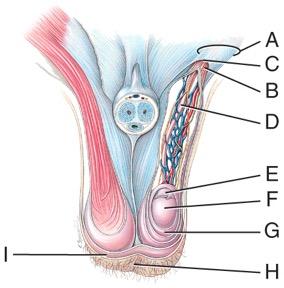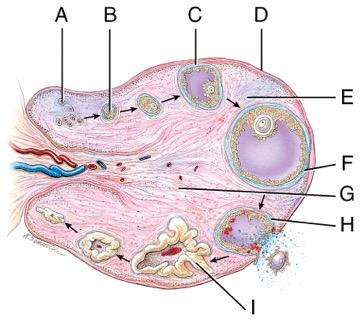Which hormone is the necessary trigger for ovulation to occur?
a. estrogen
b. Inhibin
c. LH
d. progesterone
e. FSH
f. Relaxin
c. LH
Select the correct statement about the hormonal events of the ovarian cycle.
a. days 14-28 are part of the proliferative phase
b.High estrogen levels result in a surge of LH release.
c. The follicle begins to secrete progesterone in response to estrogen stimulation.
d.The LH surge stimulates further development of the secondary oocyte.
e.Rising levels of estrogen start follicle development.
b.High estrogen levels result in a surge of LH release.
In humans, separation of the cells at the two-cell state following fertilization may lead to the production of twins, which in this case would be ________.
a.potentially of different sexes
b. fraternal
c. polyploidy
d. dizygotic
e. genetically identical
e. genetically identical
Select the correct statement about testosterone control.
a.The pineal gland is believed to be the gland that exerts the most influence in testosterone control.
b.FSH stimulates testicular production of testosterone.
c. GnRH from the hypothalamus causes FSH and LH release from the anterior pituitary.
d.Inhibin and testosterone exert positive feedback on the hypothalamus and pituitary.
c. GnRH from the hypothalamus causes FSH and LH release from the anterior pituitary.
Which hormone promotes the final step of spermatogenesis?
a. Inhibin
b. Aldosterone
c. Testosterone
d. Estrogen
e. LH
f. FSH
g. Relaxin
c. Testosterone
All but one of the events described below occur during spermiogenesis. Select the event that does not occur during spermiogenesis.
a.Excessive cytoplasm will be shed to reduce unneeded mass of the maturing sperm.
b.Mitochondria form around the proximal end of the flagellum. They will provide the ATP to drive the motion of the flagellum.
c.The centrioles migrate to the posterior end of the developing sperm to form the microtubules that make up the flagellum.
d.Mitochondrial DNA is packaged into the nucleus to be delivered to the egg during fertilization.
d.Mitochondrial DNA is packaged into the nucleus to be delivered to the egg during fertilization.
The basic difference between spermatogenesis and oogenesis is that ________.
a.during spermatogenesis two more polar bodies are produced
b.in oogenesis, one mature ovum is produced, and in spermatogenesis four mature sperm are produced from the parent cell
c.spermatogenesis involves mitosis and meiosis, but oogenesis involves meiosis only
d.the mature ovum is n, while the sperm is 2n
b.in oogenesis, one mature ovum is produced, and in spermatogenesis four mature sperm are produced from the parent cell
Which of the following will occur after ovulation?
a.The endometrium enters its secretory phase.
b.The corpus luteum secretes estrogen only.
c.The corpus luteum prepares to become a corpus albicans.
d.The secretion of anterior pituitary gonadotropins is enhanced.
a.The endometrium enters its secretory phase.
Which hormone is secreted by the corpus luteum after ovulation?
a. LH
b. FSH
c. HGH
d. Progesterone
e. Relaxin
f. inhibin
d. Progesterone
Which is not a part of the proliferative phase of the female menstrual cycle?
a.development of endometrial cells
b.late in this phase, cervical mucus becomes thin and crystalline
c.vesicular follicle growth
d.corpus luteum
d.corpus luteum
Which of the following statements is true concerning the mammary glands of both males and females?
a.The only time hormones target breast tissue is during pregnancy and lactation.
b. the best treatment option is always a radical mastectomy
c. All lumps identified in breast tissue are malignant.
d.The mammary glands are modified sweat glands that are actually part of the integumentary system.
e.Both sexes are equally prone to breast cancer.
d.The mammary glands are modified sweat glands that are actually part of the integumentary system.

What does line “A” point to?
a. Lymphatic vessels
b. Pampiniform plexus
c. Internal spermatic fascia
d. Spermatic cord
e. Fundiform ligament
d. Spermatic cord
Select the statement which is false.
a.Further genetic variation typically does not occur after meiosis I.
b.Crossing over is a source of genetic variability seen in meiosis while independent assortment is a source of genetic variability seen in mitosis.
c.Meiosis II is essential the same process as mitosis except the genetic material will not replicate before division takes place.
d.Meiosis II is essential the same process as mitosis except the starting cells are haploid (n).
e. It is a significant source of genetic variation only during meiosis I.
b.Crossing over is a source of genetic variability seen in meiosis while independent assortment is a source of genetic variability seen in mitosis.
Which structure is the site of sperm production?
a. Albuginea
b. Seminiferous tubules
c. Vas deferens
d. Raphe
e. Epididymis
b. Seminiferous tubules
The cells that produce testosterone in the testis are called ________.
a.interstitial endocrine cells
b. sustentacular cells
c. spermatocytes
d. Wolffian cells
e. spermatogonia
a.interstitial endocrine cells
All of the following things occur during meiosis I with the exception of one thing. Select the statement below that does NOT occur during meiosis I.
a.The sister chromatids are separated from each other.
b.The homologous chromosomes are separated from each other.
c.A single diploid (2n) cell has become two haploid (n) cells.
d.Portions of maternal chromosomes crossover with equivalent portions of paternal chromosomes.
a.The sister chromatids are separated from each other.
Which of the following statements about spermatogenesis is not true?
a.The secondary spermatocytes each form two spermatids.
b.occurs in the seminiferous tubules of the male testes
c.The primary spermatocyte forms two secondary spermatocytes.
d. The spermatogonium forms the primary spermatocyte.
e.Each spermatid forms two sperm.
e.Each spermatid forms two sperm.
The genetic determinate for male reproductive development is ________.
a.lack of an X chromosome
b.the SRY gene
c.inhibition of estrogen
d.presence of testosterone
b.the SRY gene
Which of the choices below is not a function of testosterone?
a.contributes to male sexual behavior and spermatogenesis
b. contributes to secondary male characteristics
c.stimulates the male pattern of development
d.stimulates protein synthesis
e.stimulates mammary gland development
e.stimulates mammary gland development
Which of the following statements about the female reproductive process is not true?
a. the first portion of the uterine cycle is the proliferative phase
b.The monthly discharge of the uterus (menses) is initiated by the decrease in secretion of female hormones.
c.Ovulation usually occurs 14 days after the beginning of menses.
d.Rebuilding the endometrium is under the control of prolactin.
e.Fertilization usually occurs in the fallopian tube.
d.Rebuilding the endometrium is under the control of prolactin.
Which structure helps regulate the temperature of the testes?
a. Dartos muscle
b. Tunica albuginea
c. Seminiferous tubules
d. Both Dartos muscle and Seminiferous tubules
e. Tunica vaginalis
a. Dartos muscle
The duct system of the male reproductive system includes all but which of the following?
a. urethra
b. corpus spongiosum
c. epididymis
d. rete testis
e. ductus deferens
b. corpus spongiosum
All of the following statements referring to the uterine cycle are trueexcept ________.
a.the corpus luteum is formed from the ruptured follicle after ovulation
b.estrogen is secreted by the developing follicle in the follicular phase of the cycle
c.FSH and LH directly promote development of the uterine endometrium
d.a decrease in the levels of ovarian hormones signals menstruation
c.FSH and LH directly promote development of the uterine endometrium

Where is the site for implantation of a fertilized ovum?
a. A
b. B
c. C
d. D
e. E
f. F
g. G
d. D

Which structure will produce progesterone, estrogens, relaxin and inhibin?
a. D
b. E
c. G
d. I
e. A
f. G
g. C
d. I